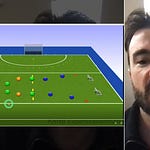Let’s watch a deep-dive into one of the game's most irresistible technical subjects: 3D elimination skills.
As Russell himself quipped, “Being a defender myself was normally on the receiving end of the 3D eliminations,” but over years on the sidelines, he’s developed a sharp appreciation for what it takes to execute (and defend against) the now-essential 3D skills in the modern game.
Key Topics Discussed
Here’s what was buzzing in the workshop:
1. The 3D Game-Changer
Russell kicked things off by underlining how 3D skills are under-trained in a game context, despite having enormous impact, especially when attackers want more than just controlled possession—they want to truly beat a defender. Defenders (like Russell in his playing days) rely on ground-level tackles—the jab, the shave, the block—all neutralized by a well-timed lift or chop.
2. Rethinking Warm-Ups: 'Drei Lauf' with a Twist
Why waste precious warm-up minutes with static passing? Russell advocated taking the classic 'Drei Lauf' exercise (a staple at Dutch clubs) and infusing it with 3D elements. Just a small tweak—like requiring a lift or chop at each set of cones—gets players dynamically moving and thinking in 3D from the first whistle.
3. Creative Use of Equipment
He encouraged using tires, high cones, and sticks to create engaging lifting and chopping challenges—especially with younger athletes (who, let’s face it, love a bit of novelty). It’s about building comfort and control in the air as much as on the turf.
4. Zone-Based Possession Drills for 3D
One of the standout drills involved a 4v4+2 possession game segmented into four zones. The kicker? Players must use a 3D move (like a lift or chop) when carrying out of a box, rather than a ground pass. Result: players start recognizing and selecting 3D options under real(ish) pressure, not just in isolation.
5. Encourage 3D Passing, Not Just Dribbling
Another handy tweak—requiring a lifted pass when moving the ball out via a pass—meant that trapping and re-controlling aerial balls were naturally integrated into every training block.
6. 3D Battle Ladder: Competing for Supremacy
Russell’s “battle ladder” series—1v1 or expanding to 2v2/3v3—is a fast, competitive drill where the winner stays on as the attacker. This not only rewards successful elimination but, as Russell wryly noted, “there’s one thing attackers don’t like and that’s defending,” so motivation to do the job right is sky-high.
7. The Critical Coaching Point: Accelerating after the Skill
It’s not enough to simply lift the ball—Russell observes far too many players “do a nice little lift and then continue to try and go through the defender again.” The key is to accelerate into the new space you’ve created—teach players to attack the space, not the man.
8. Game-Scenario Training and Reward Systems
Incorporate 3D actions into small-sided or full games by marking “3D zones” with field markers. Award double points for goals following a successful 3D elimination, or even use time penalties for defenders eliminated in a 3D duel—a fun twist that keeps sessions lively and mentally sharp.
9. Defending the 3D Attack
Russell switched to the other side of the ball for a moment to discuss defending. The classic block/jab needs to evolve—defenders must get comfortable with a narrow, staggered stance and a vertical stick to effectively shield against a flying ball. Let the ball come to you, don’t lunge in.
10. Decision-Making: When (and When Not) to Go 3D
The best players are the best decision-makers. Russell advocates encouraging 3D skills especially in tight spaces or when play slows to a halt. If there’s an opportunity in open space, sometimes a classic dummy or drag still does the trick—but in tight quarters, 3D is king.
Russell’s dad was fond of saying: “The ball can pass and the man can pass, but he can't pass both.” That should frame the core challenge every attacker and defender faces in these elimination duels.
Ready to go more in depth? Watch the full video & read on ↓













